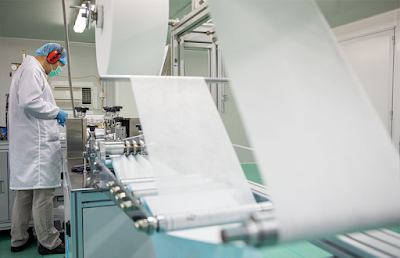Doesn't that sound fantastic? So, without further ado, here's a quick rundown of how these OEM manufacturers would manufacture using raw materials, conduct proper testing following NIOSH requirements, and more:
Manufacturing: Multiple layers of non-woven fabric specifically polypropylene, are used to make these N95 masks. The inner and exterior of the mask, which is made by spun bonding, are covered by these two external protecting layers of fabric. Spun bonding is a process that layers threads between 15 and 35 micrometres on a conveyor belt using nozzles blowing molten threads of a thermoplastic polymer (typically polypropylene) that pile up into a cloth as the belt moves down the line. Thermal, mechanical, or chemical procedures are then used to glue the fibres together. A needle woven non-woven layer is placed between the spun bonding layer and the non-woven layer to strengthen the mask's cohesion. The last layer is made up of a high-efficiency melt-down electret non-woven material that ensures maximum efficiency.
Testing: These N95 masks are now ready for testing, which is a time-consuming process. During the examinations, OEM face mask makers make certain that the created N95 masks are always above the certification threshold. The fewer rejections you have, the more money you'll make in marketing. Before being sent out for delivery, all OEM N95 masks must pass the following tests:
I. The sodium chloride aerosol spray contains charge neutralised particles with a median diameter of.3 microns. This is a particle penetration test.
II. A moderately high work rate is indicated by the airflow of 85 L per minute.
III. Exhalation resistance at 25 mm or below water column height pressure, as well as a breathing resistance test at 35 mm or below water column height pressure (A millimetre of water column height pressure is the pressure from one millimetre of water at 39 degrees F).
IV. At least 200 mg of aerosol loading, which clogs the mask with aerosol particles to simulate a high degree of exposure.
Sanitization: Under government rules, all machinery, equipment, lab tests, and masks are sanitised.
It is instantly distributed in boxes to delivery units once it has been approved by NIOSH, where you can quickly market and start selling to your clientele. The greatest advantage of OEM face mask makers is that they do not take credit for design, branding, marketing, or any marginal earnings. As a result, it's much easier to create the home of your dreams if it's already built and ready to sell.





No comments:
Post a Comment